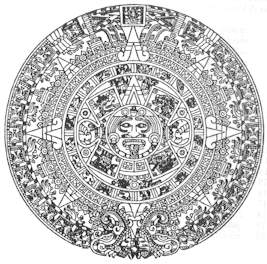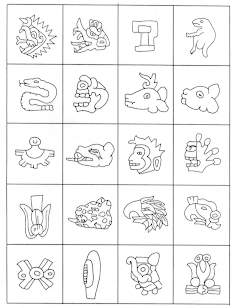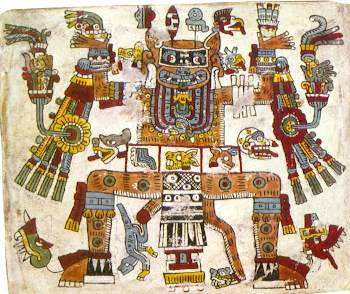|
|
||||
|
|
||||
|
|
||||
|
|
||||
| The
subject of the Mesoamerican calendars is one of the most important in the
field of the Precolumbian cultures. It translates the ancient Americans'
way of conceiving time, in relation to space, the deities, the course of
the planets and stars, the states of matter, the colors, and the other
symbols and associated elements that constitute the universe, and give
shape to cosmogony, in the native vision. Time is a "measure" (which always
presupposes a space), a module and a proportion linking the different parts
if the cosmos, and thus is an element of union among them. But above all,
it is the law, which, in its indefectible observance, makes all of this
possible. For we notice that its presence-manifested by movement-obeys
the standards and periodic rhythms that bind together beings, phenomena,
and things, establishing parameters, analogies, and prototypes that lead
immediately to the idea of one single universal model, whose manifestation
is the totality of the possible, and its most evident expression universal
life, along with nature as a symbol thereof.1
Time, then, is always present time. It is not something generated in the beginning and subsisting as an abstract component of psychophysical reality. Rather, it expresses that very reality now. It is one of the conditions of reality-that is, an ever-present element without which life would be impossible. Its quality, then, is that of a constitutive part of the cosmos, and its manner of manifestation-which can be measured quantitatively in space-the way in which time expresses itself, and therefore a key to an understanding of its essence, is a valid module for creation as a whole. In this perspective, the revolutions of the planets and stars in the firmament will obviously be of particular importance. Being stable, in comparison with the rapidity of the movement of the earth, they will of course serve as guides, and points of reference, for the establishment of the general standards of the whole-the harmony of what Pythagoras called the "music of the spheres"-which is achieved by the interaction of all individual motions, including that of the earth, and involves what is produced on the earth, beginning with the human being.2 The latter, in the Precolumbian cultures, did not live in isolation, as if divorced from the cosmogony, as we have said. After all, for traditional cultures, all life is one, despite its multiple manifestations of various orders. In that flux, in that navigation, whose protagonist is the human being, objects change their form, and phenomena constantly succeed one another, as do the moods of the gods, especially those linked with atmospheric phenomena and with the earth, which are speedier and more changeable in comparison with the near-impassibility of the loftiest deities, who are much slower, and far more ancient, and ply the sky with such imposing majesty. If all of this occurs in time, and if time constitutes a part of life, then this will all be expressed in the human person, whose being is not without time. That is, the standards that fix the stars and planets in the firmament are equivalent to those of the earth and human beings. Nor are the periods and cycles that characterize these latter by any means arbitrary. They correspond to a universal plan, which each part reflects in its own fashion, with the sum total being the archetypal whole-the model which repeats itself without variation and is expressed by "measures," symbolic modules, and numbers in their limitless mutual interrelationships, creating this astounding universe. It is of this world of analogies, which shape the cosmos, time, and life, that the Mesoamerican calendars treat, be the chiseled in stone or the painted in codices, be they those of the great eras (likewise registered in myth, rite, and symbol), or the lunar and solar calendars-or the extremely complex tonalámatl (or the Mayan tzolkin), a veritable synthesis of relationships, a full expression of the cosmovision of the Mesoamericans, and their knowledge of the universal laws.3
The names of the twenty days in the Aztec calendar are the following, and each is identified with a symbol, sign, or glyph:7
The Tonalámatl On the other hand, this tonalámatl had been adjusted to the cycles of Venus and the Sun, as we shall presently see. Of course, it was also adjusted to the other planets and stars, as is obvious in the case of the Pleiades, the Pole Star, and the Milky Way (called Cloud Serpent, or Saint James' Road). But its principal relationship was with the precession of the equinoxes, which is the third motion of the earth (the first, as we know, being the daily, or rotational, while the second is the annual, or that of revolution), like the wobbling of a top-a retrograde movement (as well as one of revolution) inverse to the daily revolutions of the planets, such that the signs of the zodiac appear to have shifted backwards an arc of thirty degrees every 2,160 years, and to complete this entire cycle in 25,920. After all, in our current astronomy, heir to the conceptions of the Chaldeans and the Persians, the sky is divided into twelve zodiacal signs.8 There can be no doubt that the Mesoamericans were familiar with this grand cycle, and that they would not have neglected to make observations and calculations in accordance with the knowledge they had of the other celestial bodies and their revolutions. Again, all traditional astronomies have known it, and have regarded it as one of the supreme cycles: the great year of the earth. We think it to be the inner key of the tonalámatl. It has been calculated at 26,000 years (in "round numbers") as well as by other peoples who have adopted it as the basis of their astronomical speculations-or, to put it another way, who have made use of it in order to understand the cosmic rhythms and laws reflected in these numbers and this cycle. The "great year," however, has customarily been conceptualized as consisting of one-half of this cycle: 13,000 years. This is the case with the Persians and the Greeks. The tonalámatl, or ritual calendar, combines the twenty signs or symbols of the days with the first thirteen numbers. The signs of the days begin with cipactli, crocodile, and to each of the following days corresponds one of the signs, in the order that we have indicated, until xóchitl, flower, is reached. On the following (twenty-first) day, it falls to the sign of the cipactli to head the list once more, the complete cycle now being repeated in identical fashion, indefinitely. In turn, to the first glyph, or sign of the day, there corresponds the number one, and the subsequent numbers are accompanied by the signs of the corresponding days (1 crocodile; 2 wind; 3 house, and so on), up to the number thirteen. Day fourteen will bear the sign of the fourteenth day (ocelotl), but the number one will return at this point, as the first thirteen numbers are the only ones that come into play (1 ocelotl; 2 quauhtli; 3 cozcaquauhtli, and so forth). Thus, the numbers recommence every thirteen days, and the signs every twenty. Owing to the combination of numbers and signs (thirteen being a "prime number"), no number occurs twice with the same sign before the lapse of the complete cycle of 260 days (13 x 20 = 260). The 261st day will once more bear the character, ce cipactli (one crocodile), and the wheel of the tonalámatl starts all over again, repeating the same number with the same sign every 260 days, identically and indefinitely.9 According to Alfonso Caso, this tonalámatl in turn strikes a relationship with the 365-day calendar, and it is precisely this numerical combination that determines the "fastening," or fifty-two-year period-which corresponds as well to the cycle of the Pleiades-at the end of which the festival of the New Fire, or toxiuh molpilia, is always celebrated. This cycle of fifty-two years, called the xiuhmolpilli, consists of 18,980 days (365 x 52 = 18,980), which is also the least common multiple of 365 and 260. Every fifty-two years, then, the wheel of the solar calendar will have rotated fifty-two times, while that of the tonalámatl will have executed seventy-three revolutions (18,980 = 73 x 260), both calendars being found at the same point after this span of time. This will not occur again until after the lapse of the 18,980 days of the xiuhmolpilli, a period that the ancient Mexicans subdivided into four parts of thirteen years each, called a tlalpilli. The concurrence acquires its whole significance when we know, as has been shown, that the culmination of the Pleiades by the zenith at midnight, a phenomenon occurring every fifty-two years, was known. Furthermore, these civilizations took account, in their calculations, of the cycles of the synodical, or apparent, revolution of Venus, which takes (in "round numbers") 584 days. Thus, they observed that, every eight solar years (2,920 days: 365 x 8 = 2,920), five cycles of Venus elapsed (584 x 5 = 2,920); and that, as fifty-two is not a perfect multiple of eight, while its double (104) is, it happens that, every 104 years, a major cycle is completed-determined by the fact that, on the first day of that cycle, all three cycles (of the tonalámatl, the Sun, and Venus) are at their starting points, a circumstance that will recur only after 104 years or 37,960 days, since this last number (37,960) is the least common multiple of 260, 365, and 584. This double "fastening of years," or major cycle, was regarded as a fundamental unit of time, called a huehuetiliztli, or an "old age," in which Venus completes sixty-five synodical revolutions (37,960 = 584 x 65). On the other hand-to continue, now, with the "concurrences" and relationships (or points of conjuncture in the spatio-temporal, "magic" among the proportions expressed by numbers)-we observe that 260 x 18 is equal to 360 x 13, which connects the tonalámatl with the perimeter of the circumference and its division into degrees. After all, every eighteen10 periods of the tonalámatl correspond to thirteen of the xihuitl-without, in this case, adding, to the civil calendar of 360 days (in order to facilitate certain calculations), the nemontemi, the five days needed in order to strike a coincidence with the solar year. The nemontemi total, in round numbers, sixty-five days in thirteen years, which is equivalent to 260 days-the duration of a complete tonalámatl-in fifty-two years, or 130,000 days (500 complete tonalámatles) in 26,000 years. This last is the supreme cyclical period (the Great Year of the Earth, or two Great Years of 13,000 years), that of the equinoctial precession. (In this same cycle, let us recall, the Pleiades have also completed 500 times their culmination.) We reach this figure without computing the thirteen leap-year days, which correspond to the correction of the tropical year throughout each "fastening of the years," and which, in the period of the equinoctial precession, would amount to 6,500 (13 x 500) days.11 We think that leap-year days were computed only for certain calculations, and not for others. At the same time, there appear to have been differences here between the Aztecs and the Mayas-since they made different corrections-as well as in the case of the nemontemi, and the way in which those ominous days were added and computed. Multiplying by five is the same as dividing by two, if the zeros that are added or subtracted in these operations be discounted and looked upon as merely secondary elements when it comes to the central numerical symbolism and the properties of the numbers under consideration. This particularity of the numbers two and five, as indicated above, can be observed, for example, in the relationship between the fifty-two-year cycle and its double, 104 (an "old age"): 52 x 5 = 260; 52 : 2 = 26; 104 x 5 = 520; 104 2 = 52. The result is that the two cycles can be taken as analogous and equivalent, just as happens in the case of the symbols of the circumference (360o) and the semicircumference (180o). Let us indicate another example, namely for the case of the number thirteen and its double, twenty-six (13 x 5 = 65; 13 : 2 = 6.5; 26 x 5 = 130; 26 : 2 = 13). This example acquires a particular importance in view of the fact that 26,000 years (half of which is 13,000) is the period of the equinoctial precession, and that, for the Hindu tradition, a manvantara lasts 65,000 years.12 It is scarcely necessary to add that the Precolumbian traditions worked with proportional numbers, where terminal zeros in no way alter the numerical root, the key of all computations. It is evident that the number five is the core and basis of all of these calculations flowing from it, and is also the module that will intervene in the constitution of the vigesimal (and decimal) system and in the Precolumbian cosmogony. Here let us indicate that the numerical structure of the divining calendar, or the various elements that act upon it in various numbers or proportions, are the following. In the first place, we have the signs of the twenty days. Second, we have the number corresponding to each of these signs or days-and we have seen that, upon arriving at thirteen, the numbers recommence from one, although the signs (or days) number twenty. Third, besides the determination with which they are characterized by their respective numbers, each of the twenty signs of the days has a ruling numen, a governor or sovereign. Again, the number nine comes into play, since there are nine "companions" of the night (perfectly identified, and painted in the codices) who escort the signs as well-as do the deities just cited-although their cycle recommences every nine days. The tonalámatl is divided into four groups of five thirteens each, yielding a total of twenty series of thirteen. Each of these series begins with one of the successive signs, and is presided over by the deity corresponding to it. To this division into groups of thirteen there also corresponds an orientation in terms of the four directions of the universe, or quadrants of space, which is also applied to the twenty signs of the days. Certain birds are matched with the days, as well-and with their respective numina or rulers-constituting elements surely as meaningful as they are mysterious. As will be seen, these calendars are the kind of thing whose structure is so complex in itself that it is impossible to simplify it, by virtue of the interrelations it promotes. The science of astronomy is that of the "measurement" of the heavenly bodies (which, in antiquity, always constituted one and the same discipline with astrology). Accordingly, it deals with the laws of the heavens and their correspondences, which express themselves in an unlimited mode, but in a constant procession or order: on modular structures, it articulates ever changing, mutually related and coinciding, rhythms that are contained within one another. We shall make no attempt, in this brief space, to handle this topic exhaustively, although we have sought to offer an example of a calendrical schema structured in conformity with numerical guidelines, analogico-symbolical correspondences, and astronomical (and astrological) concepts that we find packaged in these constructions as an expression of the cosmogonic and magico-theurgical thought of the Mesoamericans. At all events, may we be permitted to insist, by way of conclusion, on the fact that the rotary play of the symbols-glyphs, numbers, colors, directions, and so forth-as well as of the deities, configure a situation, a framework, a single reality that exists for every day, every being, and every spatio-temporal event, signing (and conditioning) it with the specific nahual that stamps its destiny and its identity. Persons and historical events alike, and even mythical personages, bear the name of a day, each one's calendrical position being the determining seal of its proper being and the mark of the type of energies that constitute that person or event. This denomination, and the characteristics deriving from the conjunction or interaction of these astronomical cycles with other constant, precise, although movable and alternating, spatio-temporal rhythms, configure the Mesoamerican rotary calendrical system, in which beings, things, and phenomena find their metaphysical identity in their perpetual cyclical return. In other words, they attain their Destiny.13 |


